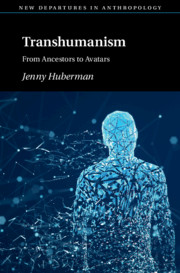Book contents
- Transhumanism
- New Departures in Anthropology
- Transhumanism
- Copyright page
- Dedication
- Contents
- Acknowledgments
- Introduction
- One Is Transhumanism a Revitalization Movement?
- Two Ancestors and Avatars
- Three Happily Ever After
- Four The Social Skin, the Antisocial Skin, and the Pursuit of Morphological Freedom
- Five Decoding the Self
- Six Rethinking Kinship Systems
- Seven From Original Affluence to Posthuman Abundance
- Conclusion
- Notes
- Bibliography
- Index
One - Is Transhumanism a Revitalization Movement?
Published online by Cambridge University Press: 10 December 2020
- Transhumanism
- New Departures in Anthropology
- Transhumanism
- Copyright page
- Dedication
- Contents
- Acknowledgments
- Introduction
- One Is Transhumanism a Revitalization Movement?
- Two Ancestors and Avatars
- Three Happily Ever After
- Four The Social Skin, the Antisocial Skin, and the Pursuit of Morphological Freedom
- Five Decoding the Self
- Six Rethinking Kinship Systems
- Seven From Original Affluence to Posthuman Abundance
- Conclusion
- Notes
- Bibliography
- Index
Summary
This chapter provides a brief history of the Transhumanist Movement in the United States by returning to Anthony Wallace's work on revitalization movements. More than half a century ago, Wallace defined a revitaliztion movement as a “deliberate, conscious, organized effort by some members of society to construct a more satisfying culture.” In this chapter I apply Wallace's model to the contemporary Transhumanist Movement with the aim of exploring how transhumanism is both like and unlike other revitalization movements studied by anthropologists. This exercise enables me to highlight features that have not been flagged in other histories of transhumanist thought. Second, it provides an opportunity to consider how transhumanism is emerging as catalyst of cultural change in the United States. Third, invoking the revitalization paradigm provides a way to recast debates as to whether transhumanism is best understood as a “new religious movement” or a secular response to the disenchantments of modernity. Finally, by returning to Wallace's work this chapter ultimately seeks to demonstrate that models are still good to think with. They help promote comparative modes of inquiry by enabling us to more readily recognize correspondences and differences between social phenonema occuring in different times and places.
- Type
- Chapter
- Information
- TranshumanismFrom Ancestors to Avatars, pp. 21 - 46Publisher: Cambridge University PressPrint publication year: 2020

